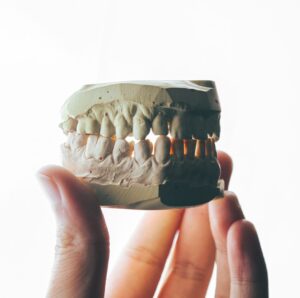 Osteogenesis imperfecta (OI), also known as “brittle bone disease”, is a rare genetic disorder of the skeleton, whose most benign form I corresponds to autosomal dominant mutations in the genes encoding type I collagen (COLA1, COLA2). Several associated skeletal manifestations are often observed but, surprisingly, while dentin defects often reflect genetic bone disorders, about half of OI patients have no obvious oral manifestations. Here, we investigated the collagen, mineral and mechanical properties of dentin from deciduous teeth collected from patients with mild form of OI and displaying no obvious clinical signs of dentinogenesis imperfecta. For the first time, an increase in the hardness of OI dentin associated with an increase in mineral content compared to healthy patients was reported. In addition, OI altered the tissue characteristics of the dentin-enamel junction but the interfacial gradient was preserved. The impact of changes in molecular structure due to mutations in OI was assessed by Raman microspectroscopy. Our results highlighted a change in the hydroxyproline-proline ratio in direct association with collagen mineralization. Our findings suggest that the evaluation of teeth could be an important aid for mild types of OI that are often difficult to diagnose clinically and provide experimental evidence that hydroxyproline content should be considered in future studies on collagen-based biomaterials. Read the whole article here.
Osteogenesis imperfecta (OI), also known as “brittle bone disease”, is a rare genetic disorder of the skeleton, whose most benign form I corresponds to autosomal dominant mutations in the genes encoding type I collagen (COLA1, COLA2). Several associated skeletal manifestations are often observed but, surprisingly, while dentin defects often reflect genetic bone disorders, about half of OI patients have no obvious oral manifestations. Here, we investigated the collagen, mineral and mechanical properties of dentin from deciduous teeth collected from patients with mild form of OI and displaying no obvious clinical signs of dentinogenesis imperfecta. For the first time, an increase in the hardness of OI dentin associated with an increase in mineral content compared to healthy patients was reported. In addition, OI altered the tissue characteristics of the dentin-enamel junction but the interfacial gradient was preserved. The impact of changes in molecular structure due to mutations in OI was assessed by Raman microspectroscopy. Our results highlighted a change in the hydroxyproline-proline ratio in direct association with collagen mineralization. Our findings suggest that the evaluation of teeth could be an important aid for mild types of OI that are often difficult to diagnose clinically and provide experimental evidence that hydroxyproline content should be considered in future studies on collagen-based biomaterials. Read the whole article here.
299
